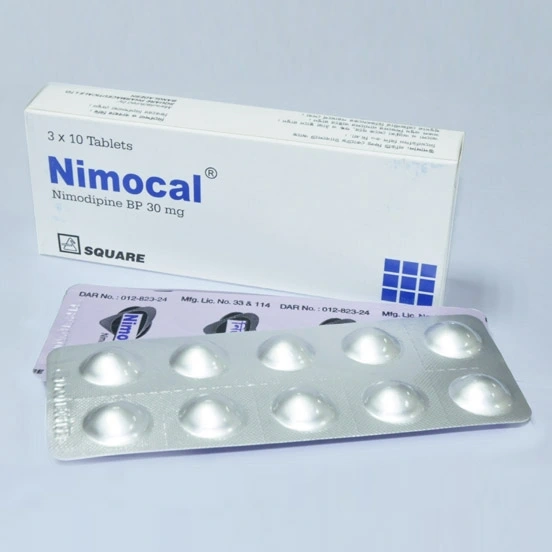Unit Price:
৳ 5.00
(3 x 10: ৳ 150.00)
Strip Price:
৳ 50.00
Indications
For the improvement of neurological outcome by reducing the incidence and severity of ischemic deficits in patients with subarachnoid hemorrhage from ruptured intracranial berry aneurysms regardless of their post ictus neurological condition.
* রেজিস্টার্ড চিকিৎসকের পরামর্শ মোতাবেক ঔষধ সেবন করুন
Pharmacology
Nimodipine is a calcium channel blocker. The contractile processes of smooth muscle cells are dependent upon calcium ions, which enter these cells during depolarization as slow ionic transmembrane currents. Nimodipine inhibits calcium ion transfer into these cells and thus inhibits contractions of vascular smooth muscle. Nimodipine had a greater effect on cerebral arteries than on arteries elsewhere in the body, perhaps because it is highly lipophilic, allowing it to cross the blood-brain barrier; concentrations of Nimodipine as high as 12.5 ng/mL have been detected in the cerebrospinal fluid of Nimodipine-treated subarachnoid hemorrhage (SAH) patients. The precise mechanism of action of Nimodipine in SAH in humans is unknown. Clinical studies demonstrates a favorable effect of Nimodipine on the severity of neurological deficits caused by cerebral vasospasm following SAH, there is no arteriographic evidence that the drug either prevents or relieves the spasm of these arteries.
Nimodipine is rapidly absorbed after oral administration, and peak concentrations are generally attained within one hour. The terminal elimination half-life is approximately 8 to 9 hours but earlier elimination rates are much more rapid, equivalent to a half-life of 1-2 hours; a consequence is the need for frequent (every 4 hours) dosing. Nimodipine is over 95% bound to plasma proteins. Nimodipine is eliminated almost exclusively in the form of metabolites and less than 1% is recovered in the urine as unchanged drug. Because of a high first-pass metabolism, the bioavailability of Nimodipine averages 13% after oral administration. The bioavailability is significantly increased in patients with hepatic cirrhosis, with Cmax approximately double that in normals which necessitates lowering the dose in this group of patients.
Nimodipine is rapidly absorbed after oral administration, and peak concentrations are generally attained within one hour. The terminal elimination half-life is approximately 8 to 9 hours but earlier elimination rates are much more rapid, equivalent to a half-life of 1-2 hours; a consequence is the need for frequent (every 4 hours) dosing. Nimodipine is over 95% bound to plasma proteins. Nimodipine is eliminated almost exclusively in the form of metabolites and less than 1% is recovered in the urine as unchanged drug. Because of a high first-pass metabolism, the bioavailability of Nimodipine averages 13% after oral administration. The bioavailability is significantly increased in patients with hepatic cirrhosis, with Cmax approximately double that in normals which necessitates lowering the dose in this group of patients.
Dosage & Administration
Adult: Initial dose is 60 mg in every four hours interval for 21 consecutive days, preferably not less than one hour before or two hours after meals. Oral Nimodipine therapy should be commence within 96 hours of the subarachnoid hemorrhage.
Use in Pediatric Patients: While there is no specific information on use of this medication in pediatric patients.
Use in Pediatric Patients: While there is no specific information on use of this medication in pediatric patients.
* রেজিস্টার্ড চিকিৎসকের পরামর্শ মোতাবেক ঔষধ সেবন করুন
Interaction
Plasma concentration and efficacy may be significantly reduced when administered with strong CYP3A4 inducers (e.g. rifampicin, carbamazepine, phenobarbital, phenytoin). May increase serum levels and toxicity of phenytoin. Increased plasma concentrations with cimetidine or sodium valproate.
Contraindications
Use within 1 mth of MI or an episode of unstable angina. Concomitant use with potent CYP3A4 inhibitors (e.g. clarithromycin, ritonavir, ketoconazole, nefazodone).
Side Effects
Although side effects from Nimocal are not common, the following can occur: headache, dizziness, flushing (feeling of warmth), heartburn, fast heartbeat, slow heartbeat, upset stomach, stomach pain, constipation, depression etc.
Pregnancy & Lactation
Large doses of nimodipine have been shown to cause birth defects in animals. Human studies have not been done. Before you take nimodipine, tell your doctor if you are pregnant or plan to become pregnant. Nimodipine may pass into breast milk but has not been reported to cause problems; caution is advised. Consult your doctor for advice.
Precautions & Warnings
Blood pressure: Nimocal has the hemodynamic effects expected of a calcium channel blocker, although they are generally not marked. Blood pressure should be carefully monitored during treatment with Nimocal based on its known pharmacology and the known effects of calcium channel blockers.
Hepatic disease: The metabolism of Nimocal is decreased in patients with impaired hepatic function. Such patients should have their blood pressure and pulse rate monitored closely and should be given a lower dose.
Hepatic disease: The metabolism of Nimocal is decreased in patients with impaired hepatic function. Such patients should have their blood pressure and pulse rate monitored closely and should be given a lower dose.
Therapeutic Class
Calcium-channel blockers
Storage Conditions
Store between 15-30° C. Protect from light.

